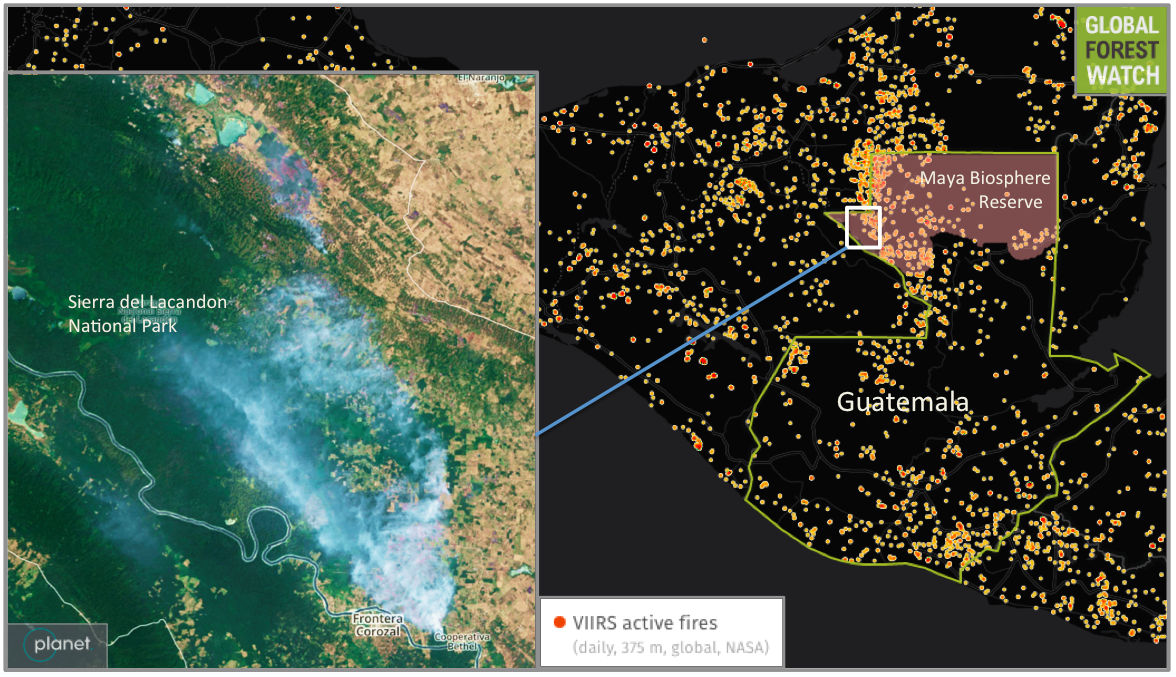- The fires have been concentrated in Maya Biosphere Reserve, a collection of protected areas – including national parks – in the country’s north.
- Officials believe many of the fires were started to clear land for illegal cattle ranching and drug trafficking.
- Declaring a state of emergency will allow agencies to more quickly deploy firefighters to affected areas.
- Community-managed areas in the biosphere reserve have seen less fire activity, reportedly due to higher fire prevention capacity.
The Guatemalan government declared a 30-day, nationwide state of emergency Tuesday to facilitate efforts to combat and control forest fires.
The Maya Biosphere Reserve covering the northernmost fifth of the country has been particularly hard hit, and firefighters are still working to get fires inside national parks under control. Community forest concessions within the biosphere reserve, on the other hand, have not been affected.
The “state of public calamity,” a classification of state of emergency under the country’s public order law, is an executive decree. It places civil and military officials under the coordination of the National System for the Prevention and Control of Forest Fires (SIPECIF) and CONRED, the country’s disaster relief agency.
The measure removes the red tape that could slow efforts, allowing government institutions to bypass the regular bidding processes required for goods and services. The government is also freeing up $27 million in emergency funds for firefighting efforts.
“This emergency clearly illustrates our country’s high level of vulnerability in the face of climate change,” presidential spokesperson Heinz Heimann said Tuesday at a press conference announcing the state of calamity.


The government had placed the Peten department under red alert April 11 due to the forest fires burning out of control in the Maya Biosphere Reserve, and particularly within the Laguna del Tigre National Park. At the time, government officials speculated the fires may have been set intentionally to clear areas for illegal cattle ranching or drug trafficking activities.
As of Tuesday, there were 16 active fires with two under control in the Maya Biosphere Reserve, the National Protected Areas Council (CONAP) said in a statement. The areas most affected are in the Laguna del Tigre and Sierra del Lacandón National Parks that are core zones of the biosphere reserve, and the Candelaria Triangle in the multiple use zone. In the latter, a fire has reportedly burned the vegetation protecting Mayan ruins.
“It’s important to mention that the fire in the Candelaria Triangle severely affected pyramids at the Las Guacamayas archaeological site, leaving them exposed and causing irreversible damage to the structures,” CONAP noted.
The impact on national parks and cultural heritage is serious and lamentable, according to Abimael Reynoso, the executive director of the Fundación Naturaleza por la Vida, one of the environmental NGOs working in the Maya Biosphere Reserve. However, the good news is that community forest concessions have remained unscathed, he said.
“The nine community concessions that are in the multiple use zone – we’re talking about roughly 476,000 hectares of forest – have fortunately been protected by the community members themselves, through the strategies they already had in place for the prevention of forest fires,” Reynoso told Mongabay in an interview Wednesday.
“It’s important to note that the communities are organized, and so they have been controlling things by carrying out patrols, and putting out any fires getting started along the borders of their concessions,” he said.
“The presence of community members in these forest concessions has really been worth it, not just in this forest fire season, but year-round,” Reynoso said.
Banner image: Firefighters battle forest fires in Guatemala. By CONAP/facebook
FEEDBACK: Use this form to send a message to the editor of this post. If you want to post a public comment, you can do that at the bottom of the page.













